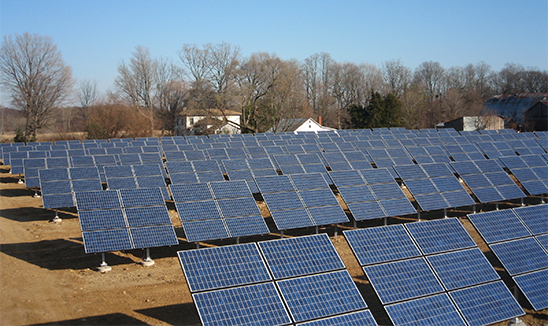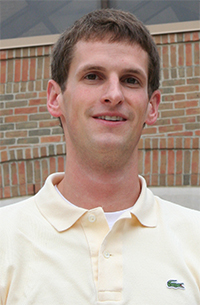Connor Field — Growing energy on a solar farm
“Energy will be the major concern in the United States for my generation,” Connor says. “Now is the time to research and invest in the technologies that will power our future.”

 Enlarge
Enlarge

 Enlarge
Enlarge
Connor Field
BA Economics 2012 exp.
BSE Electrical Engineering, 2012 exp.
Connor Field, his family, and best friend have been “growing” the latest in modern commodities – energy, at their solar energy farm in Charleston Township, Michigan. It’s the largest of its kind in Michigan, and Connor is already known as a leader in the West Michigan industry.
In early 2009, Connor was working to complete his bachelor’s degree in Economics from U-M. He was also working with his father, attorney Sam Field, on an out-of-state wind energy project. When his father learned at a wind conference that Consumer’s Energy was going to offer a feed-in-tariff program, in which the utility company agrees to buy renewable energy at a fixed price, they decided to build the largest project allowed under the rules of the program, a 150kW array.
“In the early stages of the solar project,” stated Connor, “I decided I needed a strong background in engineering.” Now pursuing a second degree in electrical engineering, he’s concentrating on taking power & energy courses and semiconductor courses that deal directly with the photovoltaic materials that are used in solar panels.
“The more I learn about the actual technology of the panels and other equipment the better off I am, which is why I’m back here,” said Connor. He will also be participating in the Summer Undergraduate Research in Engineering (SURE) program this summer working with Prof. Jamie Phillips on the project, “Solar Cell Device Making.”
His favorite aspect of solar energy is its relative invisibility compared to wind turbines. His facility can power 25 homes, yet you can be nearly on top of the field and not see it. No part of the facility is taller than 10 feet, and there are no moving parts.
Connor optimized the layout of the array to get the most energy out of the panels. For example, following the recommendations of a National Renewable Energy Lab study, he designed a rack system that allows the solar panels to be set at different angles seasonally to take maximum advantage of the position of the sun.
He predicts that the existing solar farm will have paid for itself after 12 years. During its first full year of operation, the farm produced approximately 225 MWh of electricity. It also proved to be the most efficient of the large arrays in the state, due to its unique adjustable angle racking system.
Connor and his father are continuing to pursue economically viable projects. “We have established a significant supply network, we know how to put the equipment together, we have land, and we can sell the electricity. The issue for future projects is finding a consumer for the other things of economic value besides the electricity,” stated Connor. This includes individuals who value alternative energy at a higher price than the price per kilowatt-hour of the actual electrical energy. He’d like to put together a project where he sells electricity as well as other items of economic value, such as renewable energy credits or carbon offsets.
When Connor begins to talk about the future solar industry, his economic background shines through. He says the “big driver is going to be upping the efficiency and lowering the cost of solar panels. Improved manufacturing techniques will also help with the costs, especially as we move into economies of scale. The price of panels comprises about 60% of the actual facility. Then there’s still the other 40%, which goes to the inverters and other balance of system components. As solar panel prices come down, there will be even more pressure to reduce balance of system costs incurred during installation.”
“The solar market is just coming into its own,” Connor continues. “For the past 30 years or so there weren’t enough players in the market to drive the costs down or to innovate at the production level. In recent years, regulatory changes in Europe have caused much larger demand for the actual solar equipment, which provides more incentive for people to get into the market and start producing in new and innovative ways. Through that experimentation I think costs are going to come down dramatically.”
Connor has seen a significant reduction in the price of solar panels even since he started his solar energy business. With his engineering and economics background, combined with his enterprising spirit and passion for renewable energy, we’re excited to see what he will accomplish!
In the News
Harnessing the Sun
July 28, 2010
MPlanetBlue
“Energy will be the major concern in the United States for my generation,” Connor says. “Now is the time to research and invest in the technologies that will power our future. The more rapidly they progress, the fewer environmental and geopolitical disasters we will have to endure.”
Thought Leader in Energy Connor Field: Here Comes the Sun
May 12, 2010
Business Review West Michigan
“Our greatest challenge is to continue innovating to reduce cost and increase productivity, while at the same time finding ways to maintain financial viability.”
Huge Solar Farm in Charlestown Township Near Completion
November 14, 2009
Kalamazoo Gazette
“There’s no available model for us to go and look at,” Connor Field said. “Every step we’ve taken is an innovation. It’s so big and interconnected, you have to make sure you’re creating a solution and not more problems.”
Solar Energy Farm Video
Sam Field (Connor’s father) talking about the project
 MENU
MENU 
